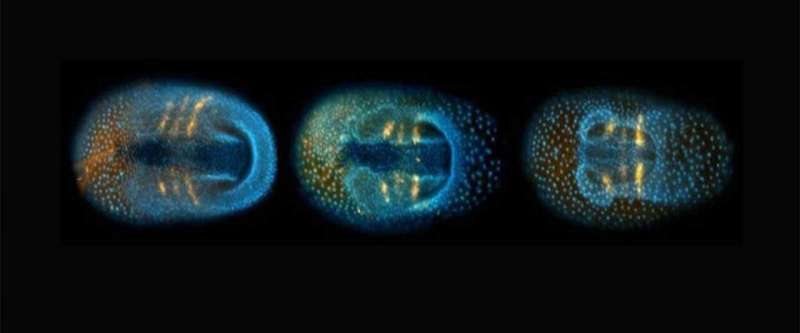Insects share the same signaling pathway to form their three-dimensional body

A signalling pathway controlling morphogenesis, the formation of the three-dimensional body shape in the fruit fly Drosophila, also has pivotal functions for early embryonic development in other insects like beetles, crickets and bugs. In these insects, the pathway is even required for the formation of the primary cell layer of the embryo. The discovery of this early function in phylogenetically distant insects suggests that the Fog (folded gastrulation) pathway fulfills a central developmental function in all insects and thus belongs to the archetypical repertoire of insect embryo formation. This is the outcome of a study Professor Siegfried Roth and his team conducted at the Institute of Zoology of the University of Cologne entitled "Fog signaling has diverse roles in epithelial morphogenesis in insects," which has been published in the journal eLife.
For their discovery of developmental genes in Drosophila, Christiane Nüsslein-Volhard, Eric Wieschaus and Edward B. Lewis were awarded the Nobel Prize in Physiology or Medicine in 1995. Some of these developmental genes have been conserved in the entire animal kingdom—from flies to humans. Others are specific to the fast mode of development of Drosophila embryos. So far, scientists believed the Fog pathway to be such a Drosophila-specific component.
The group of the Cologne-based zoologist Roth has now shown that Fog is not exclusive to Drosophila embryos. With the help of molecular methods and life imaging, the team showed that the pathway also has functions not known from Drosophila. In beetle embryos, it contributes to the migration of germ cells, the formation of extraembryonic membranes (serosa and amnion) and the formation of the first epithelial layer of the embryo. Since the latter function has also been observed in species from phylogenetically older insect lineages (bugs and crickets), it may well represent the ancestral function of the pathway.
"Our findings contribute to a better understanding of where the characteristics of Drosophila development described in all biology textbooks come from and how these developmental processes have evolved. The comparisons with other insects show that the pathway has lost functions in the evolutionary lineage leading to Drosophila," says Professor Roth. "The Fog pathway is likely to have a very old role during early morphogenesis in insects and may have acquired multiple functions during the formation and folding of cell layers."
More information: Matthew Alan Benton et al. Fog signaling has diverse roles in epithelial morphogenesis in insects, eLife (2019). DOI: 10.7554/eLife.47346
Journal information: eLife
Provided by University of Cologne



















